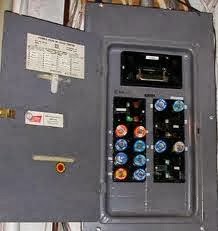Let's talk how about the safety of your electrical panel.
Many houses built from the 1950's to the 1980's were
built with a 60 amp electrical panel.
Some of these houses were built with fuses and knob and tube
wiring. These 60 amp panels and the like
worked well with the electronics that were available then. Today, homes should have at least 150 amps. With the upgrading of the National Electrical
Code laws houses with a fuse box and/or knob and tube wiring cannot be sold
unless they are upgraded to circuit breakers. Home owners who still have this type of wiring are playing Russian
roulette with their home and family.
The basics of the circuit breakers inside your electrical panel are designed to guard your home's electrical system against circuit overload, short circuits and outside power surges coming into the panel. When an overload occurs, a breaker protects you by tripping, thus shutting down the power to the circuit. However, if a breaker is defective or not operating properly, the risk of fire to the panel and consequently to your home becomes imminent.
During the 1950's to the 1980's many homes were installed
with two potentially dangerous electrical panels and breakers. These two electrical panels have major
manufacturing and design flaws that put homeowners and their families at
risk. They are Federal Pacific and Zinsco
Electrical Panels. These panels were
known to overheat and cause fires. One
of the earlier Federal Pacific panel designs was called the Stab-lok residential
circuit breakers and panels. There are millions of people today who have panels
that are more than 40 years old. These
outdated panels may no longer protect their homes from over-currents and short
circuits.
This video is real, from Channel 4 I-Team: Faulty Circuit Breakers in Thousands of Homes Could Cause Firehttp://www.nbcnewyork.com/investigations/Federal-Pacific-Electric-Circuit-Breakers-Fire-Danger-I-Team-149541115.html
I-Team: Faulty Circuit Breakers in Thousands of Homes Could Cause Firehttp://www.nbcnewyork.com/investigations/Federal-Pacific-Electric-Circuit-Breakers-Fire-Danger-I-Team-149541115.html
If you think
you may have a Federal Pacific Electric, Zinsco, or an outdated circuit breaker
panel (including knob & tube or fuses) in your home you u owe it to
yourself and your family to contact Sylvia Electrical Contracting for a free
estimate to upgrade your electrical service.
Here
are a few of the warning signs that your electrical panel needs to be updated:
One of the most important warning signs of an unsafe electrical panel is overheating. This usually occurs at the electrical panel, breaker, switch or outlet. If you open the door to your electrical panel and feel heat, there is a problem. The same applies for switches and outlets.
One of the most important warning signs of an unsafe electrical panel is overheating. This usually occurs at the electrical panel, breaker, switch or outlet. If you open the door to your electrical panel and feel heat, there is a problem. The same applies for switches and outlets.
- If you have breakers that seem to trip off more that occasionally or if there are burn marks you should call Sylvia Electrical as soon as possible. This could mean there is too much power being used on that circuit. This also applies to a GFCI in an outlet keeps tripping.
- Damage caused by rodents. Rodents have been known to chew through wire insulation in electrical panels (and other areas), creating an unsafe condition. Rodents have been electrocuted this way, leaving an unsightly mess inside the panel.
- Evidence of water inside the electrical panel. Moisture can corrode circuit breakers so that they won't trip, make connections less reliable, and make the equipment unsafe to touch.
Be safe, call today.
Here are some pictures of the panels to look for:
Federal Pacific
Zinsco
Fuse Box
knob & tube wiring






